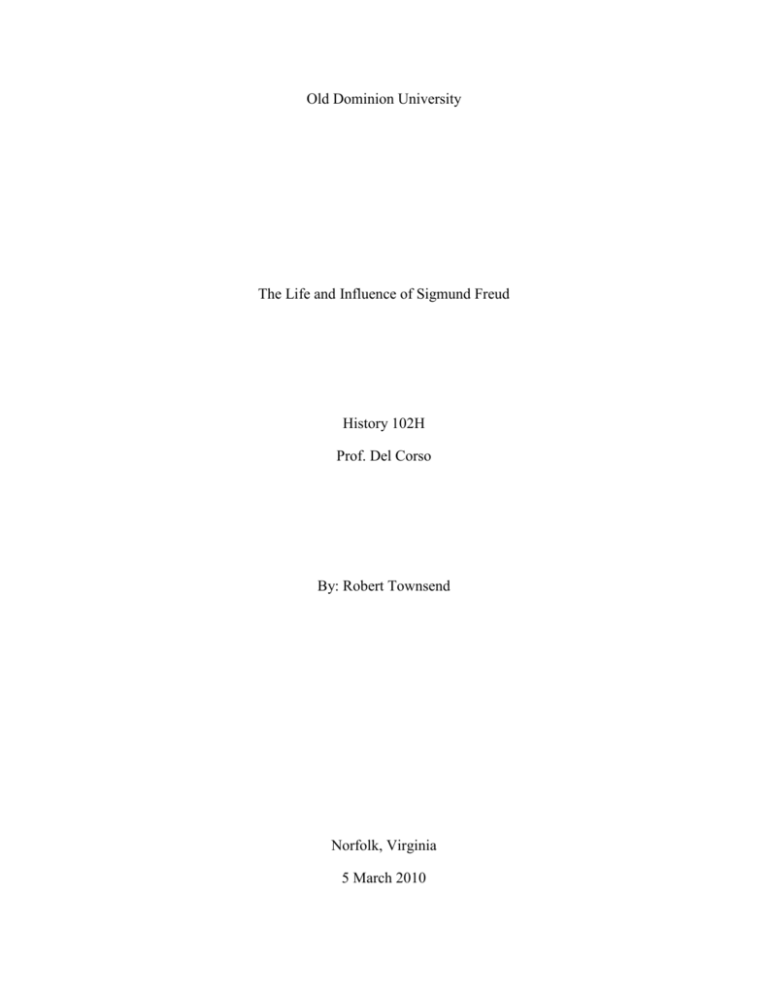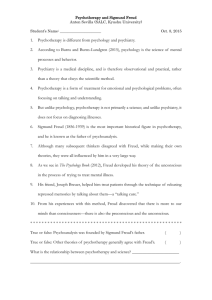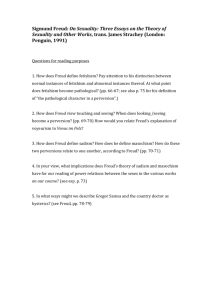The Life and Influence of Sigmund Freud
advertisement

Old Dominion University The Life and Influence of Sigmund Freud History 102H Prof. Del Corso By: Robert Townsend Norfolk, Virginia 5 March 2010 Sigmund Freud was a neurologist and psychologist from Central Europe. He was born to a thoughtful Jewish father and a very loving mother. Freud’s self-analysis of his childhood and dreams that correspond to it led to many theories and patterns, including the Oedipal complex, which he elaborated on and found in others throughout his writing and counseling career.1 The majority of his writing life was spent in Central Europe with many travels around the continent during the late 1800s and early 1900s. Freud, being openly Jewish*, was forced to immigrate to England in his late life when the Nazis took over Hungary, finally dying there in 1939. Throughout Freud’s lifetime, he wrote a countless number of influential articles and books, beginning with Psychical (Or Mental) Treatment in 1890 and authoring his last article in 1939, Moses and Monotheism.2 Freud did not simply create his theories without any help from mentors and other influences. One of the most prominent influences on how he formulated his theories was being born a Jew in Central Europe at such a hateful time, especially his ability to think critically and skeptically.3 During his lifetime, Dr. Jean-Martin Charcot and Dr. Josef Breuer most directly influenced Freud’s school of psychoanalysis. Charcot was a neurologist like Freud, and Freud’s fascination with the psychological implications regarding hysteria and hypnosis, two of Charcot’s most famed subjects, changed his focus from physical science to science of the mind.4 As Freud watched Dr. Breuer, he became increasingly interested in therapy through talking on a *While being Jewish in ethnicity and personally relating to the culture, Freud was an Atheist and maintained many quarrels with the religious part of Judaism. 1 Jean Chiriac, “Sigmund Freud’s Childhood,” Sigmund Freud- Life and Work http://www.freudfile.org/childhood.html (March 4, 2010) 2 AROPA, “Bibliography by chronological order,” Sigmund Freud- Life and Work http://www.freudfile.org/bibliography.html#chrono (March 4, 2010) 3 Philip Rieff, Freud: The Mind of the Moralist (University of Chicago Press 1959) 259. 4 PBS, “Jean-Martin Charcot,” People and Discoveries (1998) http://www.pbs.org/wgbh/aso/databank/entries/bhchar.html girl named Anna O., and Freud determined that this method could be used unlike any kind of physical therapy; it could be used to help people with problems too deep for people prior to Breuer to even comprehend and too fixated for any simple procedure to eradicate.5 Throughout his writing years, Freud investigated nearly every part of the person, both external and internal. His ideas formed the school of psychoanalysis, which is very controversial and heavily debated, but has nevertheless added definitions and theories to both psychology as well as colloquial speech in general. One of his most important and influential theories was the presence of three conflicting forces, the id, superego, and ego; the id being the innate primal desires especially sex drive in humans, the superego being the extreme need for conforming to social norms, and the ego being the balancing force between the other two.6 This theory can be used to understand not only the actions of individuals in therapy but also people throughout history. As Henk de Berg suggests, the evils of the id, which are the exact opposites of the perfection of societal norms, are the driving forces of societal change.7 One of the best examples, as well as one closest to Freud during his final years, was the tyrannous rule of Hitler and others. The people of these countries that would eventually fall to totalitarianism felt lost after their societies were destroyed during World War II, giving dictators like Hitler an easy opening towards transforming the people of Germany’s inner beliefs in a very convincing, albeit morally wrong, way. According to Freud’s theory, the leaders were able to turn the masses’ superego against the Jewish people and give their ego a feeling of control, both through Sigmund Freud, “The Origin and Development of Psychoanalysis,” The American Journal of Psychology (April 1910) 182. 6 Henk de Berg, Freud’s theory and its use in literary and cultural studies: an introduction (Camden House 2003), 50-51. 7 Berg, 60. 5 the institution of their new societal norms, while also feeding the id by giving them a complex sexual satisfaction.8 Freud’s insight on these three forces and how they govern the body is at least an impressive talking point for how human nature works, but is commonly accepted as holding many more truths than some are willing to admit. Nearly every facet of human action and interaction can somehow be related to these three forces, whether they are specifically named or not. The idea of social norms itself, which the superego is based on as mentioned earlier, is an intrinsic part of sociology, and Freud’s definition of the superego smoothly lends itself to this need to conform.9 Psychoanalysis revolutionized the psychology discipline, both popularizing it around the world as well as revealing new theories and ways of thinking that psychologists still use today. In a lecture at Clark University in 1909, Freud voiced his support for differentiating the psychological and medical disciplines, at least to an extent.10 This vision of psychology, specifically psychoanalysis, as being large and important enough to separate from medicine transformed the schooling of psychology, and even today Psychology majors commonly do not have medical degrees. Freud also popularized psychotherapy, the practice of counseling through interaction with another individual, commonly pejoratively called a “shrink.” While the success of psychotherapy is heavily debated, the use of psychotherapy by people with problems of all kinds continues to rise.11 Mark Edmundson, “Freud and the Fundamentalist Urge,” The New York Times (April 30, 2006) http://www.nytimes.com/2006/04/30/magazine/30wwln_lede.html?pagewanted=1&_r=1 9 J.J. Macionis, Society: the basics (Pearson 2009) 49. 10 Freud, 182. 11 Erica Goode, “Psychotherapy Shows a Rise Over Decade, But Time Falls,” New York Times (Nov. 20 2002) http://www.nytimes.com/2002/11/20/us/psychotherapy-shows-a-rise-over-decade-but-time8 Freud influenced the majority of psychologists who came after him one way or another. There were many who agreed with him and built off of his ideas, and many others who created ideas in order to prove him wrong, and even more who at first did not want to agree but then discovered the truths behind Freud’s claims.12 Regardless of how they come to it, Freud’s theories will be evident, whether being accepted or rejected, universally in psychological literature. Probably the most well known psychoanalytical psychologist, also known as NeoFreudians, is Carl Jung. Jung was a direct follower of Freud, and he used many of Freud’s ideas especially the id, superego, and ego and the unconscious. Eventually he further completed them and made them his own, with theories such as the collective unconscious of the human race. Jung eventually began to disagree with many of Freud’s theories, especially regarding religion and sex, however Freud’s influence on him remained strong throughout his career. He, like Freud, had a major influence on sociology, formulating his own explanations, divisive from Freud’s, for group behavior and actions.13 Two other important followers of Freud in psychology were Alfred Adler and Karen Horney. Both Horney and Adler rose to fame by using Freud’s theories, countering them, and revealing opposing conclusions, as opposed to many of Jung’s ideas which simply further completed Freud’s ideas. One of Karen Horney’s most notable theories is “womb envy,” a definitive counter to Freud’s “penis envy.” Beyond her feministic approach, however, Horney falls.html?pagewanted=1. In 1987, 3.24 percent of Americans used psychotherapy while in 1997 3.59 percent did. Even with the slight increase, the use of medication used with psychotherapy or alone doubled according to the same article, showing a clear tilt in America towards a quicker, more simplified way of escaping psychological problems. 12 Iago Goldston, “Sigmund Freud: A Critical Summary and Review,” Isis (Nov. 1949) 317. 13 Ernest W. Burgess, “The Influence of Sigmund Freud Upon Sociology in the United States” The American Journal of Sociology (Nov. 1939) 359. also helped extend Freudian work past psychoanalysis and in to behavioral psychology.14 While it was mostly in her own rite, the influence Freud had on her was clear. Alfred Adler was an early Freudian disciple and also one of the first to separate.15 Adler remained an avid supporter of psychotherapy, however he broke off and created his own branch focusing more on the individual’s problems, contrasting greatly to Freud’s suggestion and Jung’s claim of universality within the human race.16 Just like Karen Horney, Adler’s individual work was uniquely his, however the early influence by Freud remained obvious throughout his writings in many ways. Freud’s influence spread well beyond the realms of psychology and sociology. One of the most interesting parts of his self-analysis in his many books regarding it was how he defined and explained being a Jew and religion in general. Freud was a true Atheist, however he also related with the Jewish people in many senses. His thoughts on God, while not always original, brought many new creative questions to the theological forum. Freud constantly emphasized the fact that religion was fully emotional and lacked any true intelligence, a premise which he utilized in concluding religion as useless in general, a conclusion which summarized the general consensus of psychologists’ religious views of his time and which influenced others in many fields for decades.17 Author D.H. Lawrence, a contemporary of Freud, used his ideas of religion and naivety in many of his works.18 Even though many of Freud’s religious theories were very complex and occasionally confusing, the bases of his arguments remain intertwined with the Norman S. Endler, “A Behaviouristic Interpretation of the Psychotherapy System of Karen Horney” The Canadian Psychologist (April 1965) 188. 15 René DesGroseillers, “Alfred Adler,” Sigmund Freud- Life and Work (2009) http://www.freudfile.org/adler.html 16 North American Society of Adlerian Psychology, “About Adler,” Alfred Adler (2008) http://www.alfredadler.org/ 17 Rief, 256. 18 Rief, 263. 14 challenges against the truths behind God that psychologists, philosophers, and others use to this day. Sigmund Freud also had an influence on the historical analysis of Jews as a culture during the late 1800s and early 1900s. Freud, through his self-analysis in The Interpretation of Dreams, gave historians a perfect case study for how anti-Semitism affected Jews during its rise in popularity. Because Freud was born to Jewish parents, his whole life was affected by the rise in anti-Semitism, and thus his theories most likely were as well, an interesting case to study in its own.19 Freud recognized The Jewish Question, his own fear of his children having no native home, as a recurring feature in many personal dreams.20 This fear in such a strong minded individual displayed how thoroughly scared common Jews were during decades leading to the paramount of anti-Semitism: Nazism. Freud’s ideas, and most likely enjoyment of cocaine, strongly influenced art as well, mainly surrealism. Throughout his life he met with countless poets and artists, many of whom were extremely interested in his work, leading to Freud being, as psychiatrist Patrick Bracken describes, the most influential figure outside of art on surrealist painters and writers of his time.21 Some of the specific artists of whom he had direct relations and influence on include writer André Brenton, who authored a book dedicated to Freud, as well as painter Salvador Dali, whom Freud specifically enjoyed conversing with.22 Sigmund Freud and his theories as well as psychoanalysis in general was never beloved or widely accepted as truth. The dissent is sometimes so absolute that immediately after Freud’s 19 H. Stuart Hughes, Consciousness and Society (Viking Books 1977) 126. Sigmund Freud, The Interpretation of dreams (The MacMillan Company 1913) 347. 21 Patrick Bracken, “Psychiatry and Surrealism” Bulletin of the Royal College of Psychiatrists (April 1986) 80. 22 Bracken, 81. 20 work was released and until the present people constantly attempted to disprove his points and conclusions. This in itself displays the influence Freud has had on the world since the turn of the past century. Whether critics hate his theories or not, there is always at least some credibility to his claims, which should be expected as he used real life experiences of his patients and himself to create them. Freud’s deep analysis of the human mind past the conscious and into the unconscious brought about a revolution in thought and understanding of the human experience. Ideas such as the superego, psychotherapy, Freudian slips, the Oedipal complex, and more generally the permanent impact childhood has on an individual’s life are all undeniably true to an extent, and they have been all reasonably studied and expanded on or modified since Freud’s life and will almost surely be for centuries to come. Bibliography AROPA, “Bibliography by chronological order,” Sigmund Freud- Life and Work <http://www.freudfile.org/bibliography.html#chrono> (March 4, 2010) Berg, Hank de. Freud’s theory and its use in literary and cultural studies: an introduction. Rochester, New York. Camden House, 2003. Bracken, Patrick. “Psychiatry and Surrealism” Bulletin of the Royal College of Psychiatrists (April 1986): 80-81. Burgess, Ernest W. “The Influence of Sigmund Freud upon Sociology in the United States,” The American Journal of Sociology (Nov. 1939): 356-74. Chiriac, Jean. “Sigmund Freud’s Childhood,” Sigmund Freud- Life and Work <http://www.freudfile.org/childhood.html> (March 4, 2010). DesGroseillers, René. “Alfred Adler,” Sigmund Freud- Life and Work (2009) <http://www.freudfile.org/adler.html> (March 4, 2010). Edmundson, Mark. “Freud and the Fundamentalist Urge,” The New York Times (April 30, 2006) <http://www.nytimes.com/2006/04/30/magazine/30wwln_lede.html?pagewanted=1&_r= 1> (March 4, 2010) Endler, Norman S. “A Behaviouristic Interpretation of the Psychotherapy System of Karen Horney” The Canadian Psychologist (April 1965) 188. North American Society of Adlerian Psychology, “About Adler,” Alfred Adler (2008) <http://www.alfredadler.org/> (March 4, 2010) Freud, Sigmund. The Interpretation of dreams. New York. The MacMillan Company, 1913. Freud, Sigmund. “The Origin and Development of Psychoanalysis,” The American Journal of Psychology (Apr. 1910): 181-218. Goldston, Iago. “Sigmund Freud: A Critical Summary and Review,” Isis (Nov. 1949): 316-27. Goode, Erica. “Psychotherapy Shows a Rise Over Decade, But Time Falls,” The New York Times (Nov. 20, 2002). < http://www.nytimes.com/2002/11/20/us/psychotherapy-shows-a-riseover-decade-but-time-falls.html?pagewanted=1 > (March 4, 2010) Hughes, H. Stewart. Consciousness and Society. New York. Viking Books, 1977. Macionis, J.J. Society: the basics. Upper Saddle River, New Jersey. Pearson, 2009. PBS, “Jean-Martin Charcot,” People and Discoveries (1998) <http://www.pbs.org/wgbh/aso/databank/entries/bhchar.html> (March 4, 2010) Rieff, Philip. Freud: The Mind of the Moralist. Chicago, Illinois. The University of Chicago Press, 1959.







